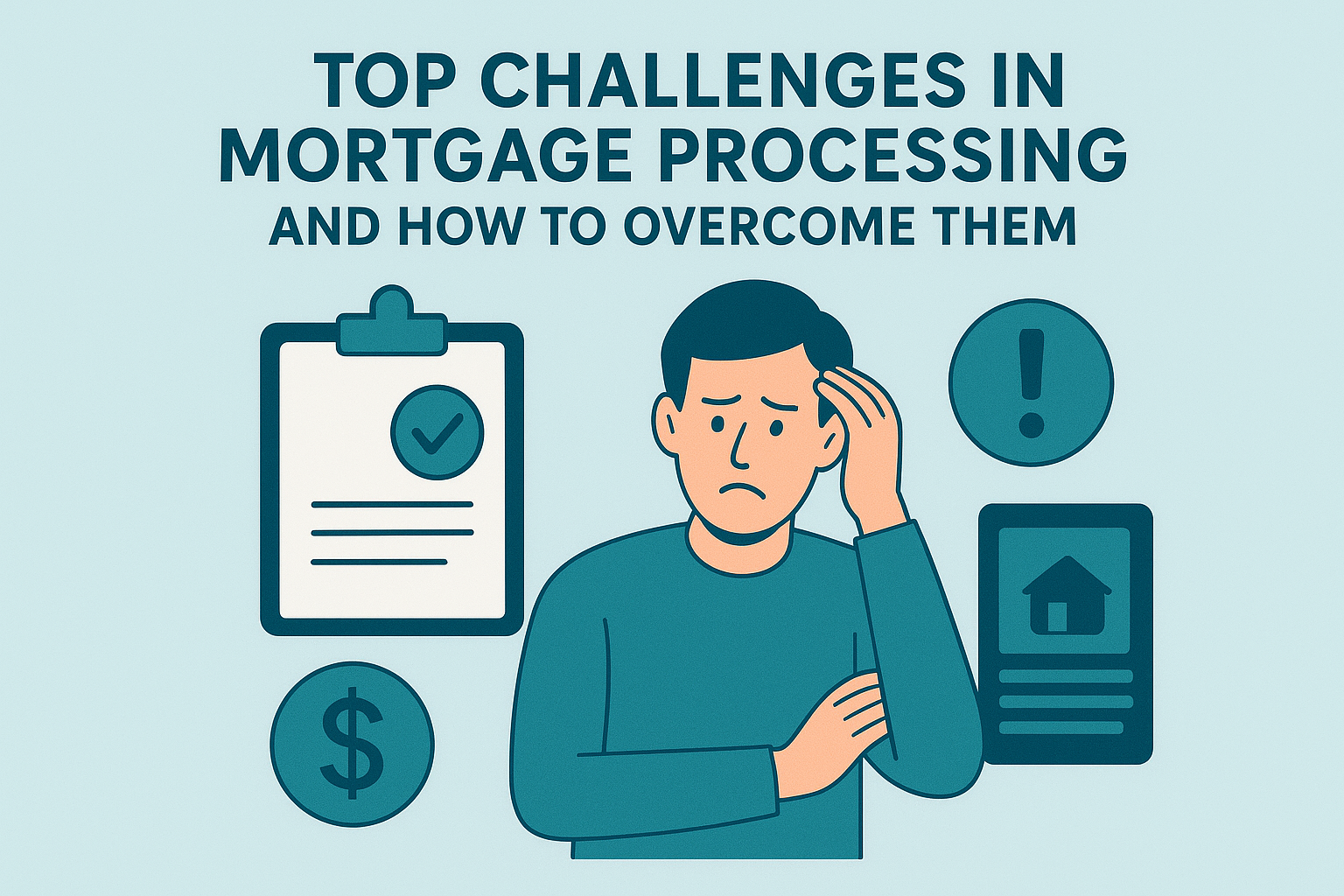If you’re in the mortgage business, you already know that getting a home loan from application to approval isn’t as simple as it sounds. It involves collecting documents, checking every detail, making sure everything follows the rules, and keeping the borrower informed — all at once. This process is called mortgage processing.
Mortgage processing is the step-by-step work done after someone applies for a home loan. It includes checking income, credit history, and property value, and making sure all documents are in place so the loan can be approved and closed. In short, it’s the behind-the-scenes work that makes a mortgage happen.
But here’s the problem that this process often takes too much time, involves too much paperwork, and is full of delays. A missing document, a manual error, or a compliance mistake can slow everything down or cause the loan to fall through. For businesses it can wasted time, higher costs, and unhappy clients.
The good news? These problems can be fixed. With smarter tools, better workflows, and support from experienced partners, mortgage processing can be faster, easier, and more accurate.
In this blog, we’ll look at the most common challenges in mortgage processing and show you exactly how to overcome them.
What is Mortgage Processing?
Mortgage processing is the process that happen after someone applies for a home loan. It involves collecting and checking all the documents needed to decide if the loan should be approved. This includes things like verifying the borrower’s income, credit history, job details, and information about the property they want to buy.
The goal is to make sure everything is accurate, complete, and follows all legal and financial rules before the loan is approved and finalised. It’s an important part of the home loan journey, and when done right, it helps both the lender and the borrower move forward with confidence.
Tackling the Top Challenges in Mortgage Processing
1. Complex and Time-Consuming Document Management
One of the most persistent mortgage loan processing problems is the sheer volume of paperwork. From borrower applications to credit reports, income verification, property appraisals, and closing disclosures, managing mortgage documents manually leads to delays, errors, and compliance risks.
How to Overcome It:
Invest in mortgage document processing solutions that offer automated classification, data extraction, and digital storage. Leveraging mortgage processing automation tools ensures faster turnaround, better tracking, and reduced human error. Additionally, outsourcing partners can streamline document-heavy mortgage workflows, saving time and freeing up internal resources.
Pro Tip: Use AI-driven document management systems that automatically flag missing or inconsistent data, reducing back-and-forth with clients.
2. Ever-Changing Mortgage Compliance and Regulatory Challenges
Mortgage compliance issues are a major burden for lenders and service providers. Constant changes in regulations from agencies like the CFPB, FHA, Fannie Mae, and Freddie Mac demand constant vigilance. Non-compliance can lead to fines, lawsuits, and revoked licenses.
How to Overcome It:
Partner with specialists who understand the mortgage compliance and regulatory challenges in your region. Compliance-focused mortgage process outsourcing companies stay current with laws, handle documentation correctly, and help you avoid penalties. Automating compliance checklists and audit trails also ensures regulatory readiness.
Pro Tip: Schedule quarterly audits and policy reviews with your outsourced compliance team to stay ahead of new requirements.
3. Processing Delays Due to Manual and Redundant Tasks
Many lenders still rely on outdated systems or manual processes that cause bottlenecks. Key stages like credit checks, income validation, or underwriting often involve redundant data entry or re-verification, leading to mortgage process inefficiencies.
How to Overcome It:
Embrace mortgage automation solutions that allow for integration across platforms. This ensures seamless data flow between CRMs, LOS systems, and underwriting platforms. Automation reduces turnaround time and increases team productivity.
Pro Tip: Use rule-based automation to trigger actions like task assignments, document requests, or alerts based on loan progress.
4. High Operational Costs and Staffing Challenges
Maintaining an in-house team for mortgage processing can be expensive. Between training, payroll, and technology investments, the operational costs skyrocket, especially during slow seasons. Moreover, hiring experienced underwriters and processors is becoming increasingly difficult.
How to Overcome It:
Turn to mortgage process outsourcing to reduce fixed costs and gain access to skilled professionals without the burden of hiring and training. Outsourcing firms can scale up or down quickly based on loan volume, making your operations more agile and cost-effective.
Pro Tip: Choose an outsourcing partner with experience in your market and the ability to integrate with your existing tech stack.
5. Inconsistent Borrower Experience
Borrowers expect a fast, seamless, and transparent process. Delays, miscommunication, or redundant document requests create a frustrating experience, leading to lost business or bad reviews.
How to Overcome It:
Centralise borrower communications and integrate customer-facing portals. Automation can send real-time updates, request missing documents, and schedule appointments. Outsourcing customer support and back-end operations can also free up your front-line staff to focus on high-touch interactions.
Pro Tip: Offer a self-service portal with real-time loan status, e-signature capability, and live chat for instant borrower support.
6. Poor Data Quality and Decision-Making Delays
Inaccurate or incomplete data during mortgage processing leads to compliance issues, underwriting delays, and poor decision-making. Manual data entry often introduces errors, especially when pulled from scanned documents or emails.
How to Overcome It:
Implement mortgage processing automation tools with AI-based validation and smart OCR (Optical Character Recognition). These tools enhance data accuracy and speed up processing. Outsourcing partners often combine automation with manual QC to ensure the highest level of data integrity.
Pro Tip: Automate data audits at each stage to catch issues before they snowball into closing-day delays.
7. Difficulty Scaling Operations Quickly
Mortgage businesses experience fluctuating demand, especially during rate changes or seasonal peaks. Scaling internal operations to meet sudden increases in loan volume without compromising service quality is a huge challenge.
How to Overcome It:
With mortgage process outsourcing, you can quickly scale your team up or down without compromising quality. Outsourcing partners typically have trained processors, underwriters, and closing specialists on standby, ready to handle spikes in volume.
Pro Tip: Use hybrid models where your internal team handles high-value or complex cases, while routine processing is offloaded to outsourced teams.
Best Practices for Streamlining Mortgage Processing
To stay ahead of the curve, mortgage businesses need more than just technology. They need a well-thought-out approach that integrates tools, people, and strategy. Here are some mortgage processing best practices:
- Automate repetitive tasks like document collection, verification, and status updates.
- Outsource non-core functions such as compliance checks, document indexing, and post-closing audits.
- Invest in training your internal team on using automation tools and maintaining compliance.
- Continuously monitor performance metrics like turnaround time, error rates, and customer satisfaction.
- Keep software integrated and updated to avoid silos and data loss.

Conclusion: Winning the Mortgage Processing Game
Mortgage processing doesn’t have to be a painful or error-prone experience. By addressing common issues such as document overload, compliance risks, manual bottlenecks, and high operational costs, you can build a more efficient and scalable mortgage operation. Whether through mortgage automation solutions or mortgage process outsourcing, the key is to adopt strategies that balance cost, compliance, and customer experience.
Businesses that proactively adopt the right tools and partnerships are not only solving today’s challenges—they’re future-proofing their operations. It’s time to streamline, simplify, and succeed.



Share this Article